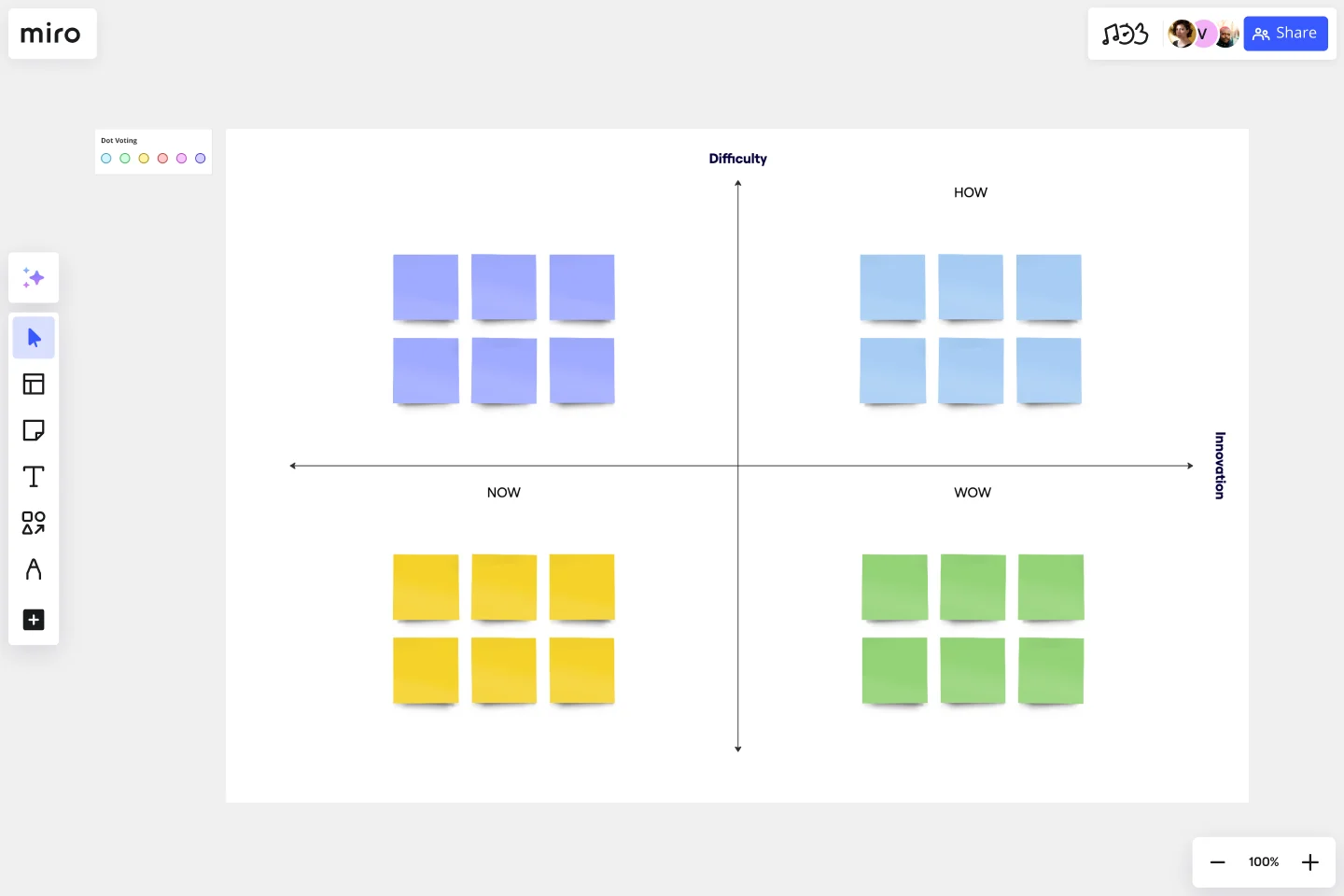How Now Wow Matrix Template
Brainstorm and organize ideas based on their originality and ease of implementation.
About the How Now Wow matrix template
What is How Now Wow?
Brainstorming is difficult — but it becomes increasingly difficult as you scale. As you release more and more innovative products and services, it’s harder for your team to get creative. Complicated workflows, hard judgment calls, and resource constraints often force you to be conservative when you’d rather take risks. To overcome this challenge and reinvigorate your team, you can use the How Now Wow matrix.
The How Now Wow matrix is a game that fosters creativity. It consists of a 2x2 matrix with “originality” on the X-axis and “feasibility” on the Y-axis. You work with your team to file your ideas into each category. Working through the matrix can empower you to overcome creative roadblocks.
How do you use the How Now Wow matrix?
The horizontal axis represents originality and rates ideas as normal or innovative. The vertical axis represents ease of implementation and rates ideas as easy or difficult to implement. Ideas that are unoriginal and challenging probably aren’t worth pursuing. “How” ideas that are innovative but difficult to execute may need further work before you can act upon them. “Now” ideas are generally considered low-hanging fruit. “Wow” ideas are both innovative and relatively easy to implement, so this is where you’ll want to try to focus your attention.
The 3 Aspects of How Now Wow
How: Difficult to implement.
This category consists of ideas that are innovative but infeasible. It’s a helpful way to set ambitious goals for the future.
Now: Easy to implement.
These ideas are familiar, so you know they work well.
Wow: Original and easy to implement.
This category describes creative ideas that are relatively simple to execute. Try to file as many ideas into this category as possible.
Who can use the How Now Wow matrix?
The How Now Wow matrix is versatile enough to be used by any number of teams. Use it whenever you’d like to encourage your team to do creative brainstorming. In order to encourage maximum creativity, you may find it beneficial to break teams into smaller groups or let people brainstorm individually before sharing their ideas with a larger group.
Get started with this template right now.
Organizational Chart Template
Works best for:
Org Charts, Operations, Mapping
Who makes up the team? What roles do they play? Who does each member report to? An organizational chart, or org chart, can answer it all at a glance. Ideal for onboarding new employees, these visual diagrams plot out company structure and the chain of command to help your team members understand reporting relationships, their role, and how they fit into the broader organization. Our template lets you choose your own chart structure and easily plot the connections between employees, roles, and departments.
3 Horizons of Growth Template
Works best for:
Leadership, Strategic Planning, Project Planning
Featured in The Alchemy of Growth, this model gives ambitious companies a way to balance the present and the future—in other words, what’s working in the existing business and what emerging, possibly-profitable growth opportunities lie ahead. Then teams across the organization can make sure that their projects map to and support the organization’s goals. The 3 Horizons of Growth model is also a powerful way to foster a culture of innovation—one that values and depends on experimentation and iteration—and to identify opportunities for new business.
Pros and Cons List Template
Works best for:
Decision Making, Documentation, Strategic Planning
A pros and cons list is a simple but powerful decision-making tool used to help understand both sides of an argument. Pros are listed as arguments in favor of making a particular decision or action. Cons are listed arguments against it. By creating a list that details both sides of the argument, it becomes easier to visualize the potential impact of your decision. To make your pros and cons list even more objective, it can help to weight each pro and con against the others. You can then present your decision with confidence, making a strong argument for why it’s the right one.
Plus Delta Template
Works best for:
Software Development, Meetings, Retrospectives
The Plus Delta template is a simple but powerful tool for collecting constructive criticism from a group. The format encourages you and your team to focus on what went well, what you should repeat in the future, and what you should aim to change. To complete a Plus Delta template, simply make note of things that are working and things you would like to improve. You can then file these elements into two separate columns. Use Plus Delta to showcase wins and learnings for your team, stakeholders, employees, and bosses.
Action Priority Matrix Template
Works best for:
Mapping
You and your teammates probably have more ideas than resources, which can make it difficult to prioritize tasks. Use an Action Priority Matrix to help choose the order in which you will work on your tasks, allowing you to save time and money and avoid getting bogged down in unnecessary work. An Action Priority Matrix is a simple diagram that allows you to score tasks based on their impact and the effort needed to complete them. You use your scores to plot each task in one of four quadrants: quick wins, major projects, fill-ins, and thankless tasks.
Mood Board Template
Works best for:
Design, Brainstorming, Ideation
When you’re kicking off a creative project, it’s sometimes important to communicate the mood you’re trying to evoke — but it’s so hard to do it with words. So create a mood board and use images, color palettes, textures, and typography. Mood boards are also perfect for gathering inspiration and sketching out and pitching ideas, and they’re not just for designers — your content writers, sales teams, and product teams can use them too, and this template makes it easy for all of you to get started.
